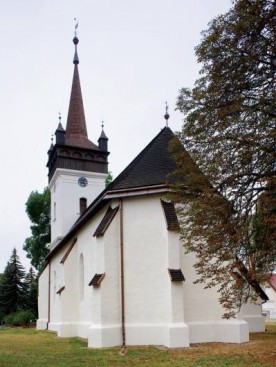The Calvinist Church – VajaThis village owned by the Vay family, belonging to the lower stratum of the aristocracy, was mentioned for the first time in 1280. The history of the settlement is inextricably linked to the history of the Vays. The village church dedicated to Saint Stephen was mentioned for the first time in 1349. After dividing the settlement another church, dedicated to Saint Emeric, had been built. This place of worship was mentioned for the first time in 1398. Its location is uncertain, although it might have stood in that part of the settlement, which is closer to Őr. Saint Stephen’s church was probably erected by the end of the 13th century. The rectangle-based nave of this church built of bricks has been preserved until today. Originally, the nave had a flat ceiling and was fortified by buttresses on its corners. The chancel arch separated this nave from the slightly trapezoidal sanctuary. The northern wall of the latter was connected to the sacristy. By the end of the 15th century, but not later than the beginning of the 16th century, the sanctuary and the sacristy were demolished. On their place a new, polygonal sanctuary of the same width as the nave was built. Buttresses attached to its corners fortify the sanctuary, which is covered by a lattice vault ceiling with ribs made of stone. The walls of the initial nave were elevated to a considerable extent and its lancet windows walled up. The entrance to the new sacristy was encased in a Renaissance style frame made of stone. The tabernacle in the northern wall of the sanctuary was put together using profiled stone carvings. After the construction work was completed, the masons applied plaster and lime coating on both sides of the walls. The church became a ruin after a while, hence, in 1609, Ferenc Vay commissioned its restoration. On this occasion, the vaulting of the sanctuary and the sacristy were demolished. During the last three hundred years, the Calvinist church of Vaja suffered several smaller or rather comprehensive refurbishments. The tower was in a bad shape already by 1820 and, consequently, had to be restored. It was repaired again in 1857 and 1871. The pinnacles of the spire were made in 1892 and a repair followed between 1932 and 1934. The church was nicely restored in the 1930s, however, the retreat of German troops by the end of the Second World War represented a salient though sad event for the church’s history. The Germans adopted a defensive position right in front of the village houses and have been attacked for three days by the Romanian army. Consequently, Vaja has been in the line of fire for three days. The tower received 6 artillery hits and became severely damaged. In its present form, the church is a single-nave, aisle-less oriented church. The sanctuary enclosed by three sides of an octagon and the nave share the same width. On the western side of the nave, one can see the three-storey, strongly emphasised tower. The following decorations emphasise it: its spire with pinnacles and the cornice divided into three segments. The entrance to the tower is encased in a stone frame, while its lentil is made of wood. The door is also decorated with embedded mirrors. The coat of arms of the Vay family, carved of stone was placed above the entrance. The first restoration in the 20th century occurred in 1974. These operations were resumed in 2007, when the tower was partially renewed and the dial of the clock changed. The last exploration and restoration was completed in 2010-2011. On this occasion, primarily the discovered architectural details of the church have been presented, but permanent exhibitions have been opened in the restored sacristy and the six levels of the tower. These exhibitions allow visitors to get thoroughly acquainted with the rich history of this small township. |




















